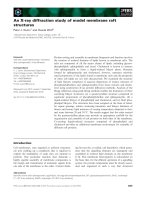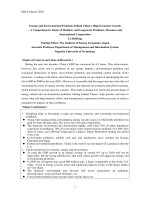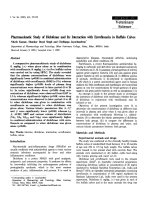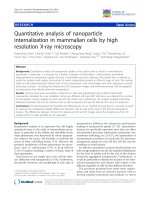High resolution x ray diffraction study of phase and domain structures and thermally induced phase transformations in PZN (4 5 9)%PT 2
Bạn đang xem bản rút gọn của tài liệu. Xem và tải ngay bản đầy đủ của tài liệu tại đây (5 MB, 12 trang )
53
Chapter 5
Surface Layer in Relaxor Ferroelectric PZN-PT Single Crystals
5.1 Introduction
An extremely broad lower 2θ peak adjacent to the major (002) R peak has
been frequently reported in standard and high-resolution XRD profiles of mechanically
polished bulk PZN-PT single crystals. Lim et al. [63] attributed this to the presence of
trapped metastable phases in the crystal. Meanwhile, Ohwada et al. [56] and Xu et al.
[57-59] reported a dual structure in PZN-PT single crystals. According to the latter
authors, the lower 2θ diffraction peak indicates a rhombohedrally distorted structure of
10 to 50 µm thick surface layer. The bulk structure, in contrast, was found to have an
average C lattice, yet the true symmetry is undetermined. Hence, the undetermined
bulk structure is termed the “X”-phase by these authors. Recently, a detailed study in
search of the “X”-phase has been performed by Kisi and Forrester [60-62]. The
“X”-phase, however, was not detected by the high-resolution neutron powder
diffractometer. Not only confirming the R phase as the bulk structure, these authors
also concluded that the structural difference between the surface and the bulk are due
to inter-domain strains, leading to distorted R structure in the surface layer. The origin
of the lower 2θ peak, however, remains unanswered.
54
In addition, x-ray penetration depth in high lead content materials remains
controversial. Normal x-ray diffraction with energy 8.048 keV performed on
PZN-8%PT sample has a penetration depth of 1
µ
m [16]. Synchrotron x-ray diffraction
of higher energy, being 18 keV, revealed similar penetration depth in PZN-8%PT
sample [32]. Meanwhile, using synchrotron x-ray diffraction at 10.7 keV, 32 keV, and
67 keV, the respective penetration depths are reported to be 13
µ
m, 59
µ
m, and 412
µ
m
of a PZN sample [57]. This suggests a nonlinear relation between the x-ray energy and
the penetration depth despite similar test samples were used. Whether the x-ray
diffraction patterns pertain to bulk structure or a mere surface layer remains
controversial although the general belief is that it reveals more the structure of the thin
surface layer.
The experimental results pertaining to the origin of the broad lower 2θ peak
adjacent to the major (002)
R
peak and the effects of surface layer on x-ray diffraction
study of PZN-PT single crystals are presented and discussed in this chapter.
5.2 Polished surface vs fractured surface at room temperature
5.2.1 Effect of polished surface on x-ray diffraction results
Typical (002) XRD profile of an as-polished sample of PZN-4.5%PT is given
in Figure 5.1(a). The XRD result, which relates to the surface layer of the as-polished
55
sample, revealed two (002) diffraction peaks: A major peak at 2θ ≈ 44.65º and a minor
but very broad peak in the range of 2θ ≈ 43.0-44.0º. The major peak relates to the (002)
R phase, and will be represented by (002)
R
in our further discussion. The origin of the
minor broad peak lying at the lower side of the major (002)
R
peak is still not well
understood at present.
Since the x-ray used can only penetrate a thin surface layer (of <a few
µ
m at
best) of the lead-based material [16, 63, 74], it is important to check if the observed
x-ray profiles pertain to the surface layer or if it is representative of the entire crystal.
To check for this, the same crystal was fractured into two halves to reveal the bulk
phase, as described in Chapter 4 Section 4.2.2. In brief, two matching slots from the
opposite sides of the sample with the cut plane were made roughly parallel to the (010)
crystal plane were made to serve as stress concentrators and the sample was fractured
into two halves by means of an impact blow. The fractured surfaces were again x-rayed.
Figure 5.1(b) shows the XRD profiles taken from the fractured surfaces of the sample.
Only a fine main (002)
R
peak at 2θ ≈ 44.62° remains and the lower 2θ peak is no
longer present. These results strongly suggest that the lower 2θ peak shown in Figure
5.1(a) pertains to the surface phase. The bulk phase revealed by the fracturing
technique, has a predominantly R structure.
To ascertain the origin of the lower 2θ peak, the fractured surface of the
56
X
-
ray
X-ray
2θ
42 43 44 45 46 47
Intensity (arb. units)
b) Fractured surface
44.62
o
b)
[001]
T
[010]
W
[100]
L
PZN
-
4.5%PT
X-ray
2θ
42 43 44 45 46 47
Intensity (arb. units)
a) As-polished surface
~43.0-44.0
o
44.65
o
a)
Figure 5.1 (002) XRD profiles of PZN-4.5%PT single crystal taken from
(a) polished surface and (b) fractured surface. A broad lower
2θ peak adjacent to the major (002)
R
peak at 2θ ≈ 44.65° was
detected from the polished surface. Only a fine main (002)
R
peak at 2θ ≈ 44.62° remains in fractured surface.
57
PZN-4.5%PT sample was polished with SiC paper of increasingly coarse particle sizes
of 1-9 µm and the newly polished surface was again x-rayed. Figure 5.2 shows that the
broad lower 2θ peak of both the samples reappeared after the polishing and that its
intensity increased with the particle size of the SiC paper used. This experiment
confirms that mechanical polishing has induced the surface domain patterns.
There are two plausible causes for the presence of the lower 2θ peak. One
likely cause is that, since the samples have been mechanically polished, the lower 2θ
peak may reflect a plastically deformed, highly dislocated, surface layer produced by
the polishing. Alternatively, the deformation process of the crystal may occur via
domain switching and structural twinning and transformation such that a lower
symmetry phase may be formed giving rise to the lower 2θ peak.
To answer the above question, HR-XRD RSM was performed on both the
as-polished and fractured surfaces of a PZN-4.5%PT crystal. Figure 5.3(a) shows the
(002) RSM taken from the fractured surface. As expected, only the major (002) peak at
2θ ≈ 44.62º was detected, indicating that the bulk is in an R state. Figure 5.3(b) shows
the RSM taken from the as-polished surface of the crystal. It is evident from these
figures that other than the main (002)
R
at 2θ ≈ 44.68º, no other distinct diffraction
peaks can be concluded. It should, however, be noted that instead of symmetrical
smearing of the intensity profile around the main (002)
R
peak, as typically observed
58
Figure 5.2 Same as Figure 5.1 but after the fractured surface of the
PZN-4.5%PT single crystal sample was polished with SiC
papers of different particle sizes. The inset gives the intensity of
the lower 2θ peak as a function of particle size of the polishing
medium, suggesting that diffraction arose from polished surface
pertains to surface layer.
59
(a) (b)
Figure 5.3 (a) (002) RSMs taken from the fractured surface of PZN-4.5%PT
showing only the main R (002) peak. (b) Same as (a) but taken
from the as-polished surface, showing the lower 2θ peak in the
ω
= 0° plane arising from the spreading (or splitting) of the (002)
R
diffraction out of the
ω
= 0° plane but toward lower 2θ values
only. The intensity contours are on log scale.
60
in internally stressed solids, the RSM of the “deformed layer” shows consistently the
following: (1) The smearing is only towards lower 2θ values such that the lower 2θ
reflection appears more like a one-sided shoulder extending from the main (002)
R
peak,
its intensity typically decreasing continuously with decreasing 2θ value in the mapping;
(2) in addition to the extended spreading in the
ω
= 0° plane, the “shoulder” also
spreads out onto the
ω
≠ 0° plane on both sides, a phenomenon resembling peak
splitting as observed in M symmetry except that no clear degeneracy peaks could be
detected in the mapping; (3) the lower 2θ peak observed in the
ω
= 0° plane (Figure
5.1a) corresponds to a possible saddle point in the mapping except that the said saddle
point remains not well-defined in the mapping in Figure 5.3(b). Lastly, should it
represent a new phase, then (4) there is a wide spread in its lattice constant and (5) the
deduced lattice dimensions normal to the surface of observation is very much larger
than the c axes (i.e., that having the largest lattice parameter) of any known phases of
PZN-PT, as judged from its Bragg’s position and the extreme broadness of the lower
2θ peak in the ω = 0° plane (Figure 5.1a).
Since we have ruled out the lower 2θ peak being arising from a plastically
deformed (or heavily dislocated) material, the above observations strongly indicate
that the lower 2θ peak must correspond to a “highly distorted R phase” owing to the
soft elastic constants of R. The mechanical softness of R and hence large piezoelectric
61
coefficients is believed to be the underlying cause of the distorted R phase [41, 42].
These “highly distorted R phase” have their c axes (i.e., that having the largest lattice
parameter) lying out of the surface of observation and is placed in intense compression
in the plane of the surface such that the lattice dimension across the specimen
thickness is further elongated due to the Poisson’s ratio effect.
The present work shows that the deformed surface layer was produced by the
mechanical polishing. It has been known that surface grinding can lead to the 90
o
switching of the ferroelastic [86] and ferroelectric [87, 88] tetragonal domains located
near the surface of the sample. This effect was explained by the compressive residual
stress parallel to the sample surface generated by grinding. In BaTiO
3
this residual
stress was estimated (from x-ray diffraction) to be ≈300 MPa [88]. Recently, it was
shown that a small <001>−directed compressive stress (<100 MPa) can induce the
transition from R to O phase in PZN-4.5%PT crystal [89].
The above observations confirm that: (a) the surface layer of R PZN-PT single
crystal can be easily deformed by mechanical polishing, and (b) deformation of R
relaxor single crystals with their c axes lying normal to the plane of the surface and are
placed in high in-plane compression. Their microscopic sizes and the highly stressed
nature, together with a spread in their lattice parameters, all contribute to the extreme
broadness of the lower 2θ peak in the x-ray profile.
62
Subsequent XRD (Figure 5.4) and HR-XRD (Figure 5.5) measurements were
also performed on as-polished (001)-cut unpoled PZN-7%PT, PZN-8%PT, PZN-9%PT,
and PZN-10.5%PT single crystals. To expose the bulk material, the same samples were
later fractured into two halves and were again x-rayed as shown in Figures 5.4 and 5.5.
Further evidence on mechanical polishing induced surface layer was shown in
PZN-7%PT sample. Figure 5.6 shows that the broad lower 2θ peak of the PZN-7%PT
sample reappeared after the polishing and that its intensity increased with the particle
size of the SiC paper used. Compared with the polished surface, the crystal bulk (as
revealed by the fractured surface) shows:
1) absence of the lower 2θ peak
2) narrow FWHM (Full-Width Half Maximum) for the R peak
3) minimum peak convolution when multiple peaks (or phases) are present.
5.2.2 Effect of polished surface on polarized light microscopy results
Under polarized light, two different types of domain patterns were found to
exist in as-polished PZN-4.5%PT single crystal plates. By varying the depth of focus
with the turning knob of PLM, the top layer was found to be about 20-40
µ
m thick,
which had elongated domains lying roughly along the [010]
pc
polishing direction
(Figure 5.7a). In contrast, the domains in the bulk of the crystals are relatively faint but
may also assume any of the following configurations: spindle-like, spearhead-like or
63
2θ
42 43 44 45 46 47
Intensity (arb. units)
f) PZN-9%PT
Fractured surface
44.28
o
44.94
o
44.50
o
2θ
42 43 44 45 46 47
Intensity (arb. units)
e) PZN-9%PT
As-polished surface
44.94
o
~43.5-44.8
o
2θ
42 43 44 45 46 47
Intensity (arb. units)
2θ
42 43 44 45 46 47
Intensity (arb. units)
c) PZN-8%PT
As-polished surface
44.65
o
~42.50-44.20
o
44.60
o
d) PZN-8%PT
Fractured surface
2θ
42 43 44 45 46 47
Intensity (arb. units)
a) PZN-7%PT
As-polished surface
44.70
o
~42.50-44.20
o
2θ
42 43 44 45 46 47
Intensity (arb. units)
b) PZN-7%PT
Fractured surface
44.64
o
Figure 5.4 (a), (c) and (e) (002) XRD profiles taken from the as-polished
surface of PZN-7%PT, PZN-8%PT and PZN-9%PT, respectively.
(b), (d) and (f) same as (a), (c) and (e) but taken from the fractured
surface.
64
(a) PZN-8%PT
As
-
polished surface
(b) PZN-8%PT
Fractured s
urface
(e) PZN-9%PT
As
-
polished surface
(f) PZN-9%PT
Fractured
surface
(c) PZN-10.5%PT
As
-
polished surface
(d) PZN-10.5%PT
Fractured
surface
Figure 5.5 (a), (c) and (e) (002) RSMs taken from the as-polished surface of
PZN-8%PT, PZN-9%PT and PZN-10.5%PT, respectively. (b), (d) and
(f) same as (a), (c) and (e) but taken from the fractured surface. The
intensity contours are on log scale.









